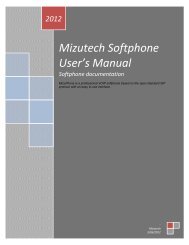Admin Guide - VoIP software provider
Admin Guide - VoIP software provider
Admin Guide - VoIP software provider
- No tags were found...
Create successful ePaper yourself
Turn your PDF publications into a flip-book with our unique Google optimized e-Paper software.
Since all data is stored in the SQL database, you have to protect only your database (the program directory can be recreated anytimeby simple file copy or reinstall. Only the database path is stored here in the mizuserver.ini file which need to be reentered correctlyafter a restore).Although there is no special maintenance needs with the mizu server, to have a working backup is a very important task to be set andtested properly. The mizu server will automatically create backups on the same server (without any additional settings), but for a realbackup you have to change the backup directory to another physical location.For more reability you should use the MS SQL backup related capabilities instead of using the mizutech built-in backup methods.3.5.2. What is a backup?A backup refers to making copies of data so that these additional copies may be used to restore the original after a data loss event. Backups areuseful primarily for two purposes. The first is to restore a state following a disaster (called disaster recovery). The second is to restore smallnumbers of files or records after they have been accidentally deleted or corrupted.There are also many different ways in which the data storage devices can be arranged to provide geographic redundancy, data security, andportability.Any backup strategy starts with a concept of a data repository. The backup data needs to be stored somehow and probably should be organized to adegree. Different repository models have different advantages. This is closely related to choosing a backup rotation scheme.Unstructured: An unstructured repository may simply be a stack of floppy disks or CD-R/DVD-R media with minimal information about whatwas backed up and when. This is the easiest to implement, but probably the least likely to achieve a high level of recoverability.Full + Incremental: A Full + Incremental repository aims to make storing several copies of the source data more feasible. At first, a full backup (ofall files) is taken. After that, any number of incremental backups can be taken. There are many different types of incremental backups, but they allattempt to only backup a small amount of data relative to the full backup. Restoring a whole system to a certain point in time would requirelocating the full backup taken previous to that time and the incremental backups that cover the period of time between the full backup and theparticular point in time to which the system is supposed to be restored. The scope of an incremental backup is typically defined as a range of timerelative to other full or incremental backups. Different implementations of backup systems frequently use specialized or conflicting definitions ofthese terms.Differential: A differential backup copies files that have been created or changed since the last normal or incremental backup. It does not markfiles as having been backed up (in other words, the archive attribute is not cleared). If you are performing a combination of normal and differentialbackups, restoring files and folders requires that you have the last normal as well as the last differential backup.Continuous data protection: Instead of scheduling periodic backups, the system immediately logs every change on the host system. This isgenerally done by saving byte or block-level differences rather than file-level differences. It differs from simple disk mirroring in that it enables aroll-back of the log and thus restoration of old image of data.
















